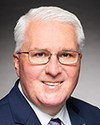Thank you very much, Mr. Chair and committee members, for having me here today to speak about our main estimates.
It's always a pleasure to join you, and I appreciate the important work you've been doing on the backlog and on supports for the veterans organizations and our veterans' families and caregivers.
As I've told you before, reducing wait times has been my absolute top priority as minister. I'm confident that we're on the right track to meet our goal of having the backlog under control next year. The backlog is currently down to about 15,000 applications from around 23,000 this time last year. More and more decisions are being made every single day.
Last June we presented a plan to tackle the backlog, using everything from new hires to digitization. In the 2020 fiscal update, we committed nearly $200 million in additional funding to put this plan into action. This plan has been making progress.
We have hired and trained the veteran benefit teams. This next quarter will be the first when they all will be up and running for the whole time, and we expect to see increased numbers of decisions month after month.
There is certainly a lot still to do, and too many veterans are still waiting too long, but the number of decisions being made and the decrease we've seen in the backlog—15,000 today, down from 23,000 last year—show that we're moving in the right direction.
You'll see that the main estimates are over $1 billion higher than last year's. This includes an increase of nearly $870 million for disability benefits and nearly $175 million for income support.
We need this funding largely because we're making faster decisions, approving more applications and getting benefits to veterans faster. That is nearly $1 billion more than last year going directly to the veterans, and well over $2 billion more than in 2014-15. There's still more to do, but I'm sure that all of us here can agree that this is important progress.
It's also worth noting that this work on wait times has taken place during a global pandemic. Since the pandemic started, employees at Veterans Affairs have been reaching out directly to veterans to check in and make sure they're okay. We'll continue to reach out in the weeks and months to come.
Because it affects our veterans just like it affects our serving members, I want to briefly address the reports that we have been hearing about sexual misconduct in our armed forces. Like you, I have been deeply troubled by the stories we've been hearing. Signing up to serve with the flag on your shoulder comes with its own risks. An unsafe workplace should never be one of them. No matter the rank, there is no place for the kind of misconduct we've been hearing about.
I want to stress how important it is for those who may be impacted to reach out. We've been working regularly with veterans and advocates on this issue of support for victims of military sexual trauma. We have services and support available through Veterans Affairs. No one should face these issues alone. We set up the Office of Women and LGBTQ2 Veterans and we've held women veterans forums to help identify and address the unique needs of the women who have served Canada in uniform.
Veterans Affairs Canada exists to offer support and assistance. Whether that relates to sexual misconduct, a post-traumatic stress injury or any other issue that one of our veterans may be facing, we want to help. We recently funded McMaster University through the veteran and family well-being fund for an intervention strategy for veterans who have PTSD after experiencing sexual misconduct during service. We always need to do more, and this is certainly an issue that we will continue to work on.
In conclusion, the main estimates are critical for the department to deliver on its mandate to serve our veterans and their families.
Thank you so much, Mr. Chair.





